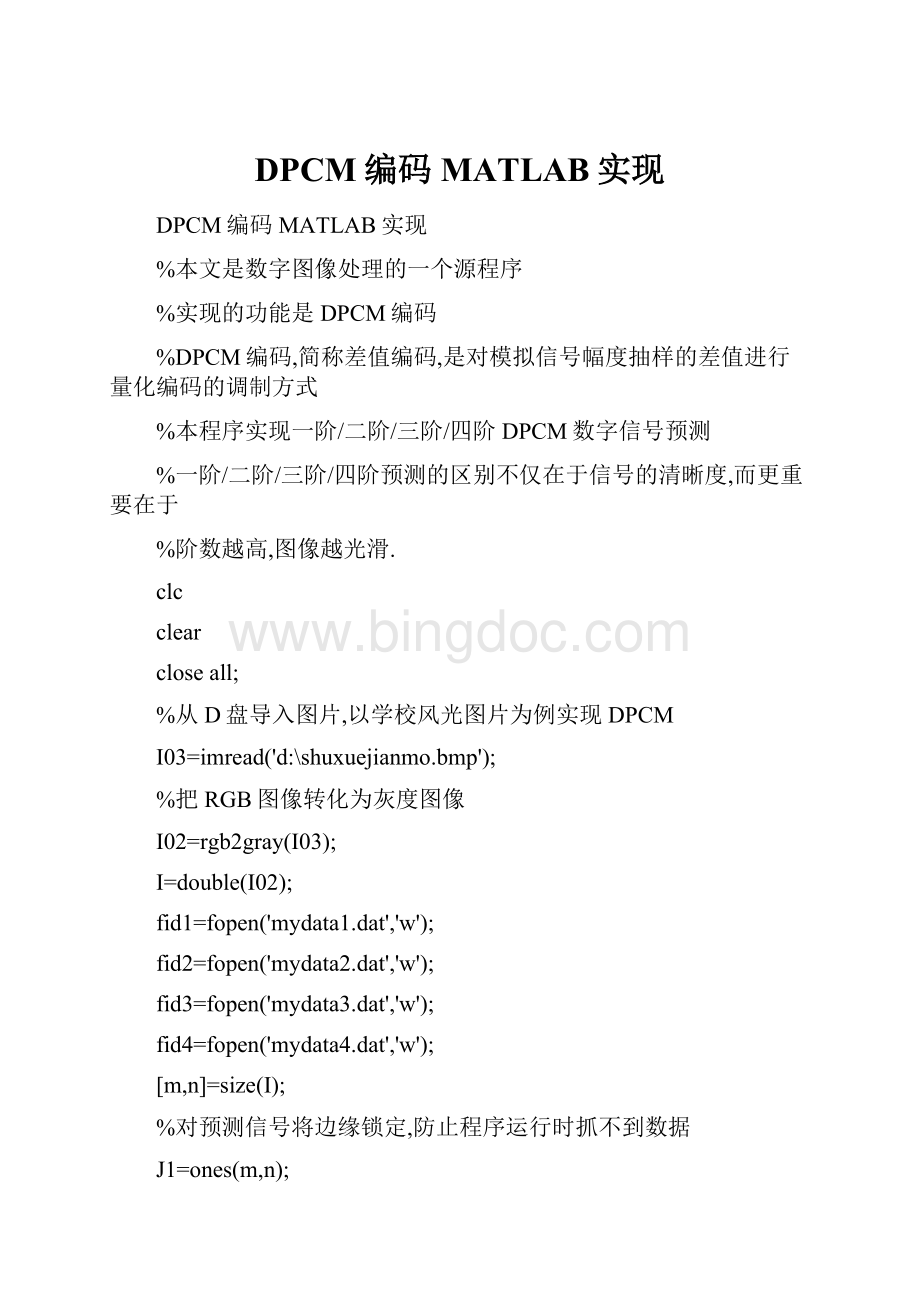DPCM编码MATLAB实现.docx
《DPCM编码MATLAB实现.docx》由会员分享,可在线阅读,更多相关《DPCM编码MATLAB实现.docx(17页珍藏版)》请在冰点文库上搜索。

DPCM编码MATLAB实现
DPCM编码MATLAB实现
%本文是数字图像处理的一个源程序
%实现的功能是DPCM编码
%DPCM编码,简称差值编码,是对模拟信号幅度抽样的差值进行量化编码的调制方式
%本程序实现一阶/二阶/三阶/四阶DPCM数字信号预测
%一阶/二阶/三阶/四阶预测的区别不仅在于信号的清晰度,而更重要在于
%阶数越高,图像越光滑.
clc
clear
closeall;
%从D盘导入图片,以学校风光图片为例实现DPCM
I03=imread('d:
\shuxuejianmo.bmp');
%把RGB图像转化为灰度图像
I02=rgb2gray(I03);
I=double(I02);
fid1=fopen('mydata1.dat','w');
fid2=fopen('mydata2.dat','w');
fid3=fopen('mydata3.dat','w');
fid4=fopen('mydata4.dat','w');
[m,n]=size(I);
%对预测信号将边缘锁定,防止程序运行时抓不到数据
J1=ones(m,n);
J1(1:
m,1)=I(1:
m,1);
J1(1,1:
n)=I(1,1:
n);
J1(1:
m,n)=I(1:
m,n);
J1(m,1:
n)=I(m,1:
n);
J2=ones(m,n);
J2(1:
m,1)=I(1:
m,1);
J2(1,1:
n)=I(1,1:
n);
J2(1:
m,n)=I(1:
m,n);
J2(m,1:
n)=I(m,1:
n);
J3=ones(m,n);
J3(1:
m,1)=I(1:
m,1);
J3(1,1:
n)=I(1,1:
n);
J3(1:
m,n)=I(1:
m,n);
J3(m,1:
n)=I(m,1:
n);
J4=ones(m,n);
J4(1:
m,1)=I(1:
m,1);
J4(1,1:
n)=I(1,1:
n);
J4(1:
m,n)=I(1:
m,n);
J4(m,1:
n)=I(m,1:
n);
%一阶DPCM编码
fork=2:
m-1
forl=2:
n-1
J1(k,l)=I(k,l)-I(k,l-1);
end
end
J1=round(J1);
cont1=fwrite(fid1,J1,'int8');
cc1=fclose(fid1);
%二阶DPCM编码
fork=2:
m-1
forl=2:
n-1
J2(k,l)=I(k,l)-(I(k,l-1)/2+I(k-1,l)/2);
end
end
J2=round(J2);
cont2=fwrite(fid2,J2,'int8');
cc2=fclose(fid2);
%三阶DPCM编码
fork=2:
m-1
forl=2:
n-1
J3(k,l)=I(k,l)-(I(k,l-1)*(4/7)+I(k-1,l)*(2/7)+I(k-1,l-1)*(1/7));
end
end
J3=round(J3);
cont3=fwrite(fid3,J3,'int8');
cc3=fclose(fid3);
%四阶DPCM编码
fork=2:
m-1
forl=2:
n-1
J4(k,l)=I(k,l)-(I(k,l-1)/2+I(k-1,l)/4+I(k-1,l-1)/8+I(k-1,l+1)/8);
end
end
J4=round(J4);
cont4=fwrite(fid4,J4,'int8');
cc4=fclose(fid4);
%=====================================================================
%以上是DPCM编码的编码过程,为了使程序具有连贯性,将编码和解码放在同一个M文件目录下
%=====================================================================
%以下是DPCM解码
fid1=fopen('mydata1.dat','r');
fid2=fopen('mydata2.dat','r');
fid3=fopen('mydata3.dat','r');
fid4=fopen('mydata4.dat','r');
I11=fread(fid1,cont1,'int8');
I12=fread(fid2,cont2,'int8');
I13=fread(fid3,cont3,'int8');
I14=fread(fid4,cont4,'int8');
tt=1;
forl=1:
n
fork=1:
m
I1(k,l)=I11(tt);
tt=tt+1;
end
end
tt=1;
forl=1:
n
fork=1:
m
I2(k,l)=I12(tt);
tt=tt+1;
end
end
tt=1;
forl=1:
n
fork=1:
m
I3(k,l)=I13(tt);
tt=tt+1;
end
end
tt=1;
forl=1:
n
fork=1:
m
I4(k,l)=I14(tt);
tt=tt+1;
end
end
I1=double(I1);
I2=double(I2);
I3=double(I3);
I4=double(I4);
J1=ones(m,n);
J1(1:
m,1)=I1(1:
m,1);
J1(1,1:
n)=I1(1,1:
n);
J1(1:
m,n)=I1(1:
m,n);
J1(m,1:
n)=I1(m,1:
n);
J2=ones(m,n);
J2(1:
m,1)=I2(1:
m,1);
J2(1,1:
n)=I2(1,1:
n);
J2(1:
m,n)=I2(1:
m,n);
J2(m,1:
n)=I2(m,1:
n);
J3=ones(m,n);
J3(1:
m,1)=I3(1:
m,1);
J3(1,1:
n)=I3(1,1:
n);
J3(1:
m,n)=I3(1:
m,n);
J3(m,1:
n)=I3(m,1:
n);
J4=ones(m,n);
J4(1:
m,1)=I4(1:
m,1);
J4(1,1:
n)=I4(1,1:
n);
J4(1:
m,n)=I4(1:
m,n);
J4(m,1:
n)=I4(m,1:
n);
%一阶解码
fork=2:
m-1
forl=2:
n-1
J1(k,l)=I1(k,l)+J1(k,l-1);
end
end
cc1=fclose(fid1);
J1=uint8(J1);
%二阶解码
fork=2:
m-1
forl=2:
n-1
J2(k,l)=I2(k,l)+(J2(k,l-1)/2+J2(k-1,l)/2);
end
end
cc2=fclose(fid2);
J2=uint8(J2);
%三阶解码
fork=2:
m-1
forl=2:
n-1
J3(k,l)=I3(k,l)+(J3(k,l-1)*(4/7)+J3(k-1,l)*(2/7)+J3(k-1,l-1)*(1/7));
end
end
cc3=fclose(fid3);
J3=uint8(J3);
%四阶解码
fork=2:
m-1
forl=2:
n-1
J4(k,l)=I4(k,l)+(J4(k,l-1)/2+J4(k-1,l)/4+J4(k-1,l-1)/8+J4(k-1,l+1)/8);
end
end
cc4=fclose(fid4);
J4=uint8(J4);
%分区画图
figure
(1)
subplot(3,2,1);
imshow(I03);
%隐藏坐标轴和边框,以免坐标轴与标题重叠
axisoff
boxoff
title('原始图像','fontsize',11,'fontname','隶体');
subplot(3,2,2);
imshow(I02);
axisoff
boxoff
title('灰度图像','fontsize',11,'fontname','隶体');
subplot(3,2,3);
imshow(J1);
axisoff
boxoff
title('一阶预测','fontsize',11,'fontname','隶体');
subplot(3,2,4);
imshow(J2);
axisoff
boxoff
title('二阶预测','fontsize',11,'fontname','隶体');
subplot(3,2,5);
imshow(J3);
axisoff
boxoff
title('三阶预测','fontsize',11,'fontname','隶体');
subplot(3,2,6);
imshow(J4);
axisoff
boxoff
title('四阶预测','fontsize',11,'fontname','隶体');
%学会DPCM编码必须彻底了解DPCM编码原理
%DPCM编码是数字图形处理的一项应用
%Removingallvariables,functions,andMEX-filesfrommemory,leavingthe%workspaceempty.
clearall
%Deletingallfigureswhosehandlesarenothidden.
closeall
%Deletingallfiguresincludingthosewithhiddenhandles.
closeallhidden
%ClearingallinputandoutputfromtheCommandWindowdisplaygivingusacleanscreen.clc
%Openingthefile'TEOTH.mp3'inthereadaccessmode.
fid=fopen('TEOTH.mp3','r');
%Generatingtheinputsignal'm(t)'byreadingthebinarydatain16bit
%integerformatfromthespecifiedfileandwritingitintoamatrix
%'m(t)'andthenumberofelementssuccessfullyreadisreturnedintoan
%outputargument'count'.
[m,count]=fread(fid,'int16');
%Redefiningthecountforefficiency.
count=8500;
%Settingthesamplingfrequency.
%becausetheaudiosignalhasamaximumfrequencyof4Kandaccordingto
%Nyquistcriteria,wegetthefollowingsamplingfrequency.
Fs=8000;
%Settingthesamplinginstant.
Ts=1;
%Settingthenumberofsamplestobeused.
No_Samples=(2*Fs)+Ts;
%Definethetimevectorforthecalculations.
time=[1:
Fs/64];
%Calculatingmaximumvalueoftheinputsignal'm(t)'.
Mp=max(m)
%Settingnumberofbitsinasymbol.
bits=5;
%Numberoflevelsofuniformquantization.
levels=2^bits;
%Calculatingthebitrate.
bit_rate=8000*bits;
%SincetheDPCMisimplementedbythelinearpredictor(transversal%predictor)Hencesettingupthepredictioncoefficient'alpha'.
alpha=0.45;
%Transmittingthedifference.
%Sincethereisnoestimatedvaluebeforethefirstsamplesowegetdiff_sig
(1)=m
(1);
%Calculatingtherestofthevaluesofthedifferencesignalwiththehelp%ofcoefficient.
fork=2:
count,
diff_sig(k)=m(k)-alpha*m(k-1);
end
%Calculatingmaximumvalueoftheinputsignal'diff_sig(t)',i.e,tobe
%quantized.
Dp=max(diff_sig)
%Calculatingthestepsizeofthequantization.
step_size=(2*Mp)/levels
%Quantizingthedifferencesignal.
fork=1:
No_Samples,
samp_in(k)=m(k*Ts);
quant_in(k)=samp_in(k)/step_size;
error(k)=(samp_in(k)-quant_in(k))/No_Samples;
end
%quant_in=diff_sig/step_size;
%Indicatingthesignoftheinputsignal'm(t)'andcalculatingthe%quantizedsignal'quant_out'.
signS=sign(m);
quant_out=quant_in;
fori=1:
count,
S(i)=abs(quant_in(i))+0.5;
quant_out(i)=signS(i)*round(S(i))*step_size;
end
%Decodingthesignalusingthequantizeddifferencesignal.
s_out=quant_out;
s_out
(1)=quant_out
(1);
fork=2:
count,
s_out(k)=quant_out(k)+alpha*s_out(k-1);
end
%Calculatingthequantizationnoise'Nq'.
Nq=(((step_size)^2)/12)*((Mp/Dp)^2)
%Calculatingsignaltonoiseratio'SNR'.
SNR=1.5*(levels^2)
SNR_db=10*log10(SNR)
%Plottingtheinputsignal'm(t)'.
%figure;
subplot(4,1,1);
plot(time,m(time),time,s_out(time),'r');
title('InputSpeechSignal');
xlabel('Time');
ylabel('m(t)');
gridon;
%Plottingthequantizedsignal'quant_in(t)'.
%figure;
subplot(4,1,2);
stem(time,quant_in(time),'r');
title('QuantizedSpeechSignal');
xlabel('Time');
ylabel('Levels');
gridon;
%PlottingtheDPCMsignal's_out(t)'.
%figure;
subplot(4,1,3);
plot(time,s_out(time));
title('DecodedDPCMSpeechSignal');
xlabel('Time');
ylabel('Dq(t)');
gridon;
%Plottingtheerrorsignal'error(t)'.
subplot(4,1,4);
plot(time,error(time));
title('ErrorSignal');
xlabel('Time');
ylabel('Error(t)');
gridon;
%Removingallvariables,functions,andMEX-filesfrommemory,leavingthe%workspaceempty.
clearall
clearall
closeall
%Solicitatipodese馻lamuestrear
opcion=input('Escriba1siquierecodificarse馻ldeaudioo2siquierecodificarotra:
')
%abrese馻lseleccionadaporelusuario
ifopcion==1;
t_input=input('escribaeltiempoensegundosquedeseegrabarelaudio:
');
m=wavrecord(t_input*30000,30000,'int16');
%fid=fopen('sonido.wav','r');
%m=fread(fid,'int16');
ini_cuenta=10;
end
ifopcion==2;
t=input('escribaelvectordetiempoparalase馻l:
');
m=input('escribalase馻lquedeseecodificarf(t):
');
ini_cuenta=2;
end
%Solicitafrecuenciademuestreoynivelesdecuantizacion
Fs=input('escribalafrecuenciademuestreo:
');
levels=input('escribalosnivelesdecuantizacion:
');
Mp=max(m)%Calculaelnivelm醲imodelase馻l
step_size=(Mp*2)/levels%Incrementoentrecadaniveldecuant
particion=[-Mp:
step_size:
Mp];%vectordeparticion(cuant)
%particion=[0:
step_size:
2*Mp];
Ts=1;
longitud_m=length(m);
inc_muestreo=longitud_m/Fs;
red_inc_muestreo=floor(inc_muestreo);
No_samples=(red_inc_muestreo*Fs)+1;%Numerodemuestras,
%Muestreo
fork=ini_cuenta:
No_samples
ifk==ini_cuenta
samp_in(k-1)=0;
ind_pcm=1
end
residuo=rem(k,red_inc_muestreo);
ifresiduo==0
samp_in(k)=m(k);
elseifresiduo~=0
samp_in(k)=samp_in(k-1);
end
end
%Cuantizacion
quant=quantiz(samp_in,particion);
pcm_cad=dec2bin(quant)
ind_pcm=1;
%GeneracodigobinariodePCM
forh=ini_cuenta:
No_samples
residuo=rem(h,red_inc_muestreo);
ifresiduo==0
PCM(ind_pcm)=str2num(pcm_cad(h,:
));
ind_pcm=ind_pcm+1;
end
end
subplot(2,2,1);plot(m);title('se馻lanal骻ica');xlabel('tiempo');ylabel('amplitud');subplot(2,2,2);stairs(samp_in);title('se馻lmuestreada');xlabel('tiempo');ylabel('amplitud');subplot(2,2,3);plot(quant);title('se馻lcuantizada');xlabel('tiempo');ylabel('nivelesdecuantizacion');
DPCM预测编码的MATLAB原代码:
收藏
DPCM预测编码原代码:
i1=imread('3.jpg');
i1=rgb2gray(i1);
i1=imcrop(i1,[2020160160]);
i=double(i1);
[m,n]=size(i);
p=zeros(m,n);
y=zeros(m,n);
y(1:
m,1)=i(1:
m,1);
p(1:
m,1)=i(1:
m,1);